no woman no cry, no chowpati no chaay
three years ago in a german language class in mannheim, the teacher asks the students to write something about their wives/husbands/boyfriends/girlfriends. how they met, how long they've been together, how they feel towards each other. the guy from calcutta has probably the most interesting of the stories: his father browsing through the newspaper ads comes across an ad placed by his current wife's father:
"very beautiful, fair complexion, highly educated (b.sc. chemistry m.b.a. marketing & finance), gujarati brahmin, 25 yrs, 5'7", 55 kgs. belonging to well settled family. seeks alliance from good looking and well settled engineer. first preference calcutta/mumbai or abroad. caste no bar*."or something similar. seeing the astonishment in the eyes of his classmates from distant lands, pratesh hopelessly tries to explain how normal it is in his country, where basically all marriages are based on arrangement.
sitting in an internet cafe in bombay three years later, i notice every single screen around me tuned to another matchmaking site. screens filled with little thumbnails of face shots with one paragraph descriptions, mostly written by some elder family member - not "i'm looking for..." but more "my daugher/sister is looking for..." or "we are looking for...".
driving around in hassan khaan's rickshaw yesterday, he tells us about the marriage party he will attend right after dropping us home. "it's actually not a wedding. they got married seven years ago. this is to celebrate the groom picking up the bride from her family's house". it takes us a while to figure out why this hadn't been done seven years ago. if we want, we can join him. "it's important to know about other cultures" - he says, and he's more than willing to introduce us to his culture, and more probably to his friends and relatives.
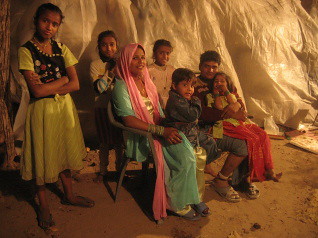
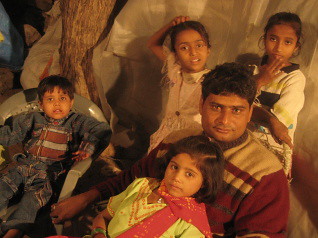
reis and his family
iqbal, a muslim earning his life carrying goods on a horse cart, is now "seventeen or eighteen" years old. he doesn't know the exact number. the wife "should be two or three years younger". somewhere between fourteen and sixteen. they've been waiting for this day for seven years, simply because the wife was too young at the time of marriage: around seven years old. gokce leaves the room with reis to meet the women in the next room, while I find myself sitting with the men, listening from hassan the stories iqbal and his wife on the first day of their marriage. "they went out together for the first time (giggles)... ate together (giggles)... at night - you know - they did it for the first time (laughs) - he's now a happy guy". his brother, reis, just outside the room, is telling gokce a story "that makes her wife laugh each time he tells it". he and his wife are childhood friends. once while playing in the garden, he throws a stone to the girl. the stone leaves a scar mark at the point it hits her face. now reis cheerfully claims that it was a deliberate act, aiming to "mark her" as his future wife.
marking may be useful for the initial booking, but the payment needs to be done before the actual contract is put into force. if the dowry paid by the woman's family (just opposite to the middle eastern practice - where the man is the one who pays) does not live up to the expectations, the marriage will not take place. or there are cases where it does take place, but terminates with implausible stories featuring the wife being killed (burned) by either the husband or his family, whose financial plans were based on the hope of receiving a good dowry one day - their son being their biggest (and perhaps the only) monetary asset. it is possible to go on telling peculiar stories like this forever (they seem virtually infinite in number to me: each day i hear or read about something even more interesting - not all negative ones of course), but i'll stop typing in encyclopaedical knowledge and just hang on to my personal observations - and go on typing about the "indian wedding" as i see it everyday from outside as a "tourist".
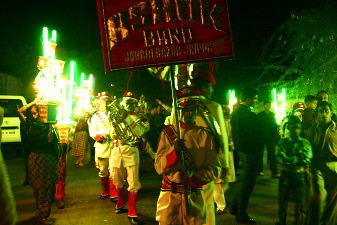
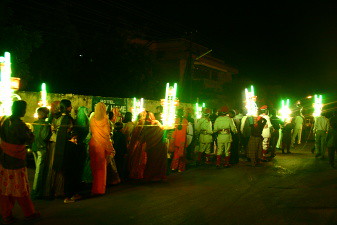
last week, on a rickshaw from the city centre to our place with other trainees, someone asks how further we still have to go. "not far. just a couple of weddings left" someone else answers. they are everywhere. on every street - around each corner - there's a wedding. the first time we saw it out of a bus window in ajmer a few weeks ago, we were fascinated with the colourful lights, tens of people walking along with a marching band and dancing like crazy. we had no idea what it could possibly be - a local holiday - or maybe the post-electoral celebrations of the winning party. then we arrived in jaipur and took a rickshaw home, where on the way we came across the same ceremony a few more times. the driver explained us that what we were seeing was an indian wedding - something we would see every evening for the following 100 days, which form the "wedding season". then we had to stop as the traffic on the road was blocked by the ceremony, and i got off the rickshaw to take the pictures you see on this page while gokce stayed with the driver and had an "exciting" conversation about "marriage".
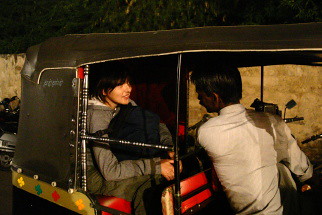
apparently, this marriage is more important than many others. more than one video cameras are recording the event while photographers are buzzing around the main gate to capture the groom entering the hall. i am lead to the same point where all other photographers stand. while'i'm trying to take pictures of the crowd dancing around, some people are pointing their fingers to the groom, to divert my attention to "the real thing" - "he" is the reason why they're there - focusing on the party doesn't have much point. taking photos is a hard task when people are walking around with a few hundred watt fluorescent tubes in their hands.
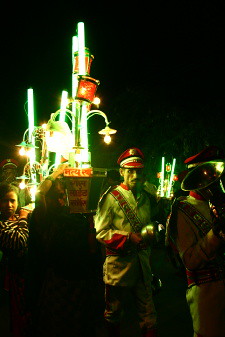
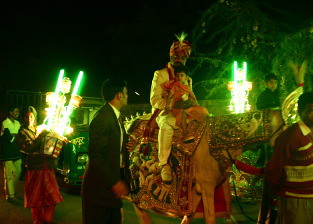
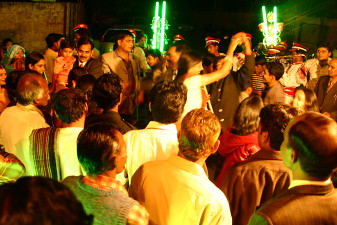
the weddings all look quite similar. what hits you in the beginning is the lights. tens of people carrying fluorescent tubes connected to each other with cables. at the very end of the convoy is a vehicle (a cart, a rickshaw, or a little truck depending on the size of the band) carrying a noisy electricity generator supplying power to the tubes. (ilk gordugumde verdigim tepki "hindistan'da 'fener alayi teknolojisi' cok gelismis" seklinde olmustu.) then there are the drummers, and the friends and the family of the groom walking, and stopping occasionally to dance in an attempt to demonstrate how happy they are to others watching them on the street. [scroll down to the bottom of this entry to download the video] somewhere towards the end of the row is the groom dressed in his white costume, sitting on a white horse and looking at the people with an expression filled with an endless pride. the bride is not there yet - she is yet to be picked from her house and brought to the wedding hall.
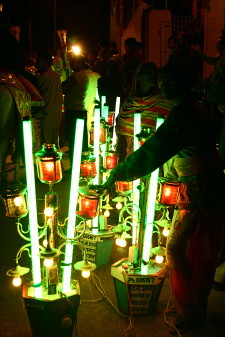
although the script runs more or less the same for every marriage, there are minor differences too. some bands are smaller, some take their jobs more seriously (in some, the members of the band seem to not care at all as they walk without any sort of order, and keep chatting and laughing while playing their instruments - we think it probably depends on the money they're paid), and some families dance crazier than the others. colour of the light varies too, though it's usually green (which makes it look like "the marriage of jedi", as gabor, a hungarian friend aptly calls it.)
it would be interesting to see what's going on inside the wedding hall after the parade, but we so far haven't got the chance to be invited to one. i'm almost sure we will be in the coming months, and we'll write more about it then. lastly, i think i can't afford to finish without including this contemporary indian proverb from reis: "no woman no cry, no chowpati** no chaay***." getting married will eliminate a lot of problems (cooking being amongst the first) from your life - though "in india there's only one problem: no problem". [arda]
*: caste no bar is a common expression used in marriage ads, meaning that the applicant does not necessarily have to be a member of a particular caste. in other cases where the caste does matter, the desired cast is included in the copy.
**: the most common form of indian bread.
**: tea (usually mixed with milk, sugar, and a blend of spices known as "tea masala".)
here's a 40-second video of one of these parades. it's a little too dark, but it gives an idea of the ambiance: DOWNLOAD/PLAY (1,5 MB). we should make a clearer one and post here later.





